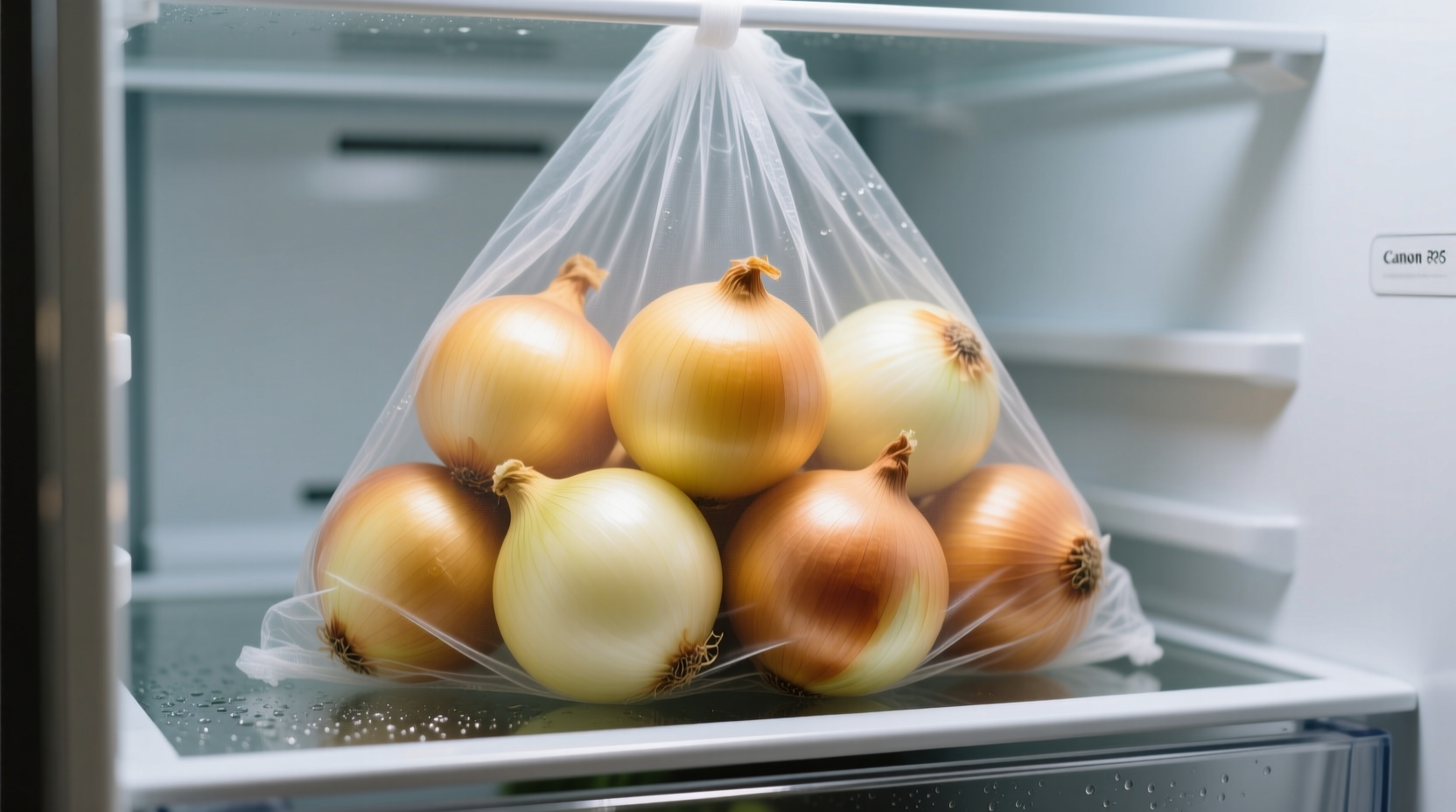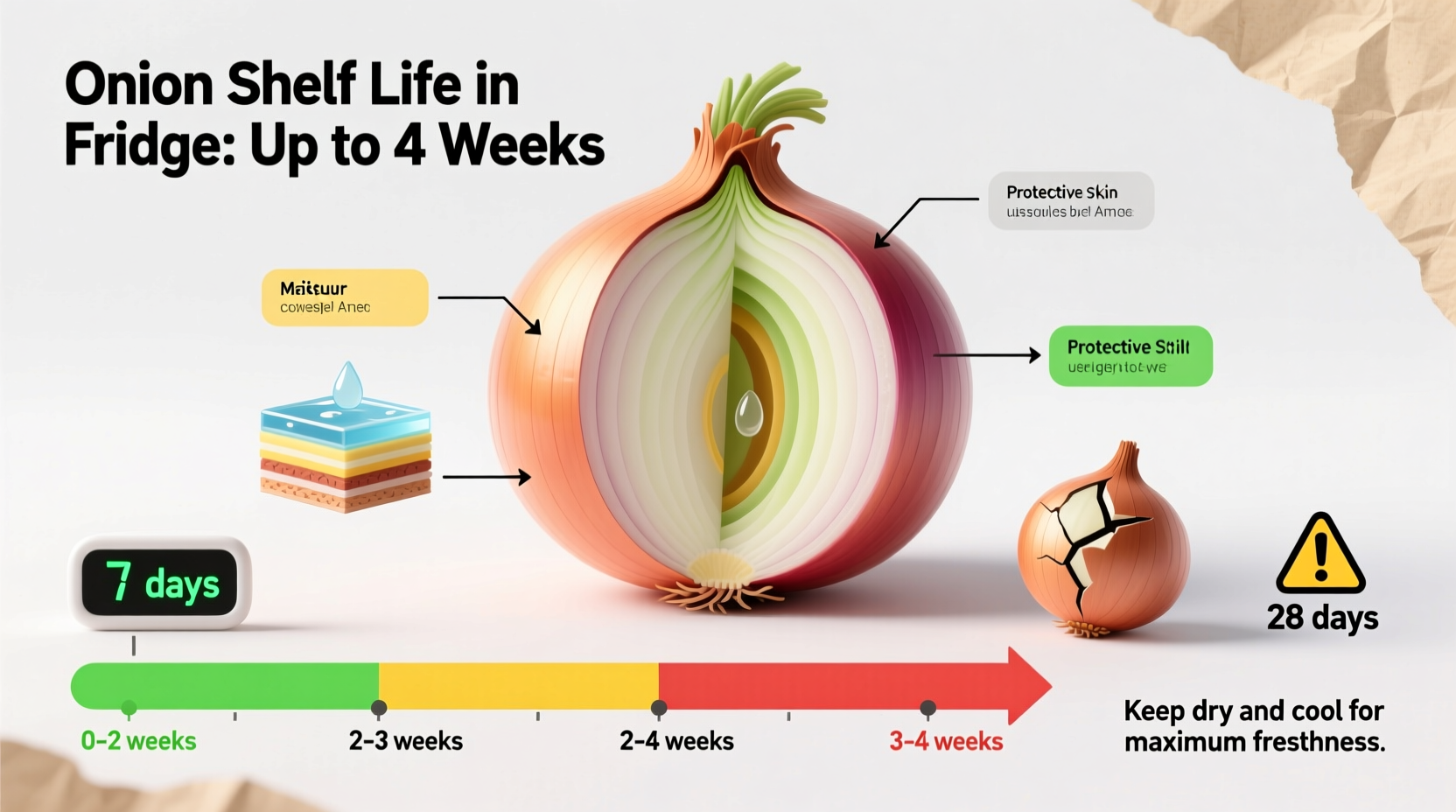Understanding Onion Shelf Life in Refrigeration
Discovering wilted onions in your refrigerator can ruin meal plans and waste money. Knowing exactly how long onions last in the fridge—and why—is essential for smart kitchen management. This guide delivers science-backed storage techniques verified by food safety experts to maximize your onion freshness.
Why Refrigeration Changes Onion Longevity
Unlike many vegetables, onions have unique storage requirements that vary by type and preparation. Room temperature storage works for whole bulbs, but refrigeration becomes necessary after cutting or for certain varieties. The key factors affecting shelf life include:
- Moisture exposure - Refrigerators create high-humidity environments that accelerate spoilage in whole onions
- Cut surface area - Exposed flesh oxidizes and degrades faster
- Varietal differences - Sweet onions spoil quicker than storage varieties
- Temperature consistency - Fluctuations promote mold growth
| Onion Type | Room Temperature | Refrigerated | After Cutting |
|---|---|---|---|
| Yellow Storage Onions | 2-3 months | 1-2 months | 7-10 days |
| Red Onions | 3-4 weeks | 3-4 weeks | 7-10 days |
| Sweet Onions | 1-2 weeks | 2-3 weeks | 5-7 days |
| Green Onions | Not recommended | 1-2 weeks | N/A |
This comparison reflects data from the FDA Food Code and University of Minnesota Extension research on vegetable preservation. Note that refrigeration extends shelf life for cut onions but can actually shorten it for whole storage varieties due to moisture absorption.
Optimal Refrigeration Techniques for Maximum Freshness
Simply placing onions in your crisper drawer won't deliver optimal results. Follow these professional-tested methods:
For Whole Onions Needing Refrigeration
- Place in mesh produce bags or perforated containers
- Store in the warmest part of your refrigerator (typically the door)
- Maintain temperature between 32-40°F (0-4°C)
- Keep away from ethylene-producing fruits like apples
For Cut Onions
- Seal in airtight containers immediately after cutting
- Press plastic wrap directly onto exposed surfaces before sealing
- Store in the main compartment (not door) for consistent temperature
- Label containers with preparation date

Recognizing Spoilage: When to Discard Onions
Consuming spoiled onions poses food safety risks. Watch for these definitive signs:
- Texture changes - Soft spots, slimy patches, or excessive dryness
- Color shifts - Darkening beyond normal aging, mold growth (white, green, or black)
- Odor development - Sour, ammonia-like, or fermented smells
- Moisture accumulation - Liquid pooling in storage containers
According to USDA Food Safety guidelines, discard onions showing any mold growth or significant soft spots. Small dry spots can be trimmed if the rest remains firm and odor-free. Never consume onions that smell sour or fermented—this indicates bacterial growth that cooking won't eliminate.
Advanced Storage Strategies for Extended Freshness
Professional kitchens employ these techniques to maximize onion shelf life:
- Vinegar misting - Lightly spray cut surfaces with 50/50 vinegar-water solution before storage
- Layered storage - Place paper towels between onion layers to absorb excess moisture
- Freezing option - Dice and freeze in oil for cooked applications (lasts 6 months)
- Separate storage - Keep onions away from potatoes which emit moisture-promoting gases
Research from the Connecticut Department of Public Health confirms that proper separation from ethylene-producing produce extends onion freshness by 20-30%. This simple adjustment prevents premature sprouting and texture degradation.
Troubleshooting Common Onion Storage Problems
Even with proper techniques, issues sometimes arise. Here's how to address them:
- Sprouting - Caused by temperature fluctuations; use sprouted onions immediately
- Excessive dryness - Increase humidity by storing in crisper drawer with humidity control set to high
- Strong odors - Store in glass containers instead of plastic which absorbs smells
- Moisture buildup - Replace paper towels daily and ensure containers are completely dry
Remember that sweet onions like Vidalias naturally have higher water content and shorter shelf lives than storage varieties. Adjust your expectations accordingly—these premium varieties typically last 50% less time than standard yellow onions even with perfect storage.
Frequently Asked Questions
Can you freeze raw onions to extend their shelf life?
Yes, raw onions freeze well for cooked applications. Chop or slice, spread on baking sheet, freeze solid, then transfer to airtight containers. Properly frozen onions maintain quality for 6-8 months but aren't suitable for raw applications due to texture changes.
Why do my refrigerated onions sprout faster than room temperature ones?
Temperature fluctuations in refrigerators can trigger sprouting. Store onions in the warmest part of your fridge (typically the door) at consistent 32-40°F. Avoid placing near cooling vents which cause temperature swings that stimulate growth hormones.
Do different onion varieties require different storage methods?
Yes, sweet onions (Vidalia, Walla Walla) have higher water content and spoil faster. Store these refrigerated even when whole. Storage onions (yellow, red) last longer at room temperature but benefit from refrigeration after cutting. Green onions always require refrigeration in water-filled containers.
How can I tell if refrigerated onions are still safe to eat?
Check for firm texture, absence of mold, and normal onion smell. Discard if soft spots exceed 10% of surface area, if slimy patches appear, or if sour/fermented odors develop. Small dry spots can be trimmed if the rest remains firm and odor-free.











 浙公网安备
33010002000092号
浙公网安备
33010002000092号 浙B2-20120091-4
浙B2-20120091-4